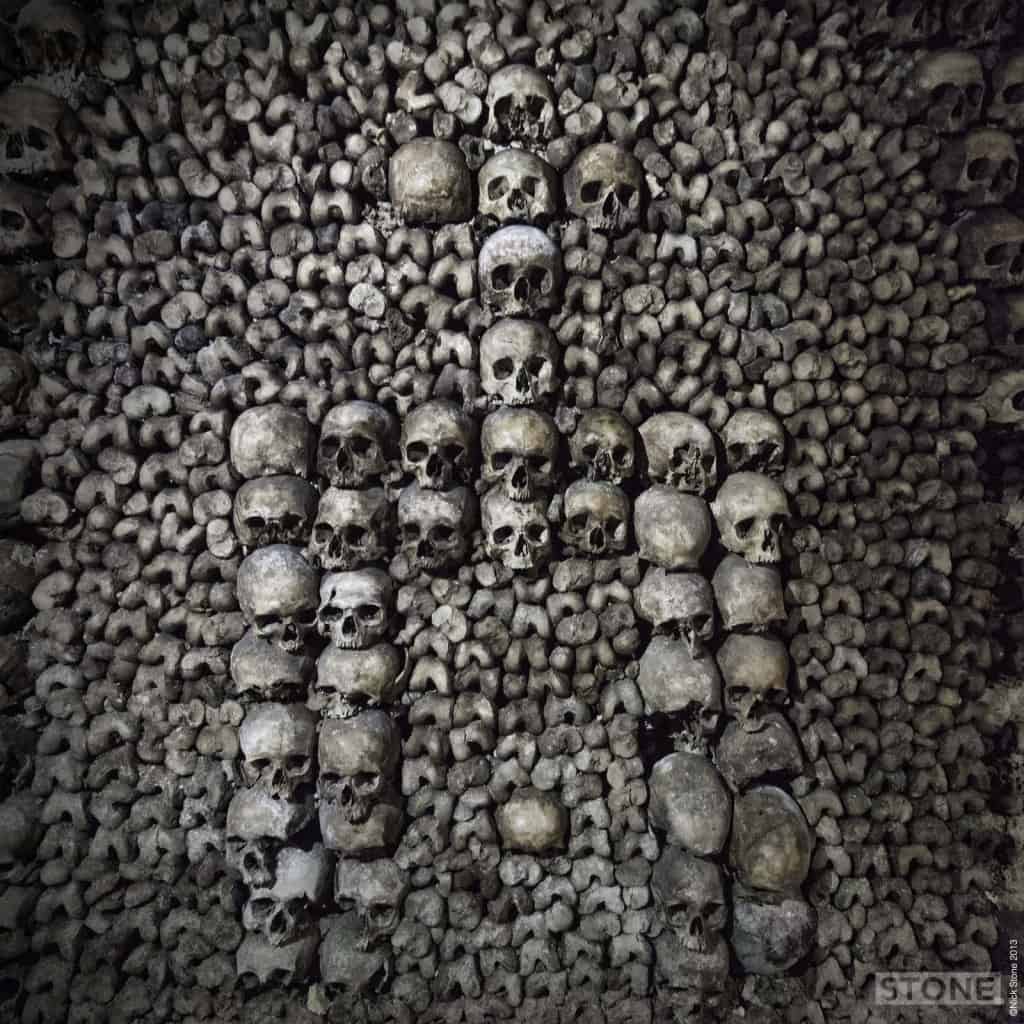Last year we shared an hour of Halloween with 6 million dead Parisians in l’Ossuaire Municipal or the Paris Catacombs, we know how to party. Twenty metres below the Place Denfert Rochero there are amazing, intricate piles of dead people dating as far back as late Roman times. The catacombs are the publicly open bit of the vast swiss cheese cut through the Cretacious, Bartonian and Cenezoic Lutecéan Limestones that keep Paris mostly on the surface, quite possibly mined for as much as two thousand years.
You enter via the Paris’s former Barrière d’Enfer city gate, spiralling down a nausea inducing stone staircase that makes your head spin you enter the old mine system. What makes it special is the fact that it is a vast dumping ground or was, for so many ex-Parisians, The cleansing starting with the Cemetery of ‘Saint Innocents’ which was very close to Les Halles which was for centuries Paris’ main food market, not something you want next to a full cemetery, Les Halles is still almost a market although more of a vast temple to Mamon/Mall/retail merde-pit near the Pompidou Centre; currently undergoing renovation the only thing I could find in its favour was the biggest Fnac (think WH Smiths in French) I’ve ever seen, I stood outside guarding bags until Le pickpockets drove me in to look at the strange French vinyl along one wall.
Saints Innocents was desperately unsanitary, so full it was spilling out above the surface, over 6ft of stinking earth and bone, established possibly in the 5th century including some probable Roman burials it had grown into a vast bone dump not just for the church, but a hospital and the local morgue. The density had already prompted the removal of older burials and the stacking of some of the bone in passageways and crypts in the area. This is of the way in many medieval cities; Norwich for instance has more medieval churches than any other city north of the Alps, a fair number of these have graveyards that are the height of the cemetery walls, St Georges Colegate and St John Maddermarket are two that immediately come to mind, over-burial after over-burial for hundreds of years pushing the surface upwards towards the inhabitants’ ungrateful maker who wasn’t interested in that bit anyway. The general seepage, leakage, fluid and stink from Saints Innocents being so close to somewhere you could go and buy a baguette provoked an outrage. The final straw came when the cellar of an adjoining building collapsed and filled up with earth and body parts. This event seems to have resulted in the end of this massive playground for Typhoid, Cholera and god knows what else being removed to elsewhere along with quite a few of the other graveyards from Paris’ Centre Ville.
So the decision was made and under Police Lieutenant-General Alexandre Lenoir A massive dissemination of the human bone structure began at night in carts, it took two years and initially was haphazard, although the bones were kept in distinct parishes and still are. Once Louis-Étienne Héricart de Thury, the head of the Paris Mines took control he started organising; arranging the bones by femur and skull for solidity, with backfill in humerus, radius, ulna, metatarsals and indeed anything else bone shaped, these developed into patterns with mortality busting signs added by the state and wags and bits of poems and bible verse dotted about. Over time some of the more obvious skulls have developed a varnish-like gloss from many hands brushing past. There was also a security guard fast asleep listening to his iPod, that’s how normalised it becomes I suppose, a little bit of me hopes he was listening to death metal. You can of course as is standard everywhere go to the handily placed ‘Mort’ gift shop at the exit and buy some overpriced over-proofed Absinthe to hasten your entry into the catacombs of the future, a clockwork skull or bottle opener and all manner of other proto-goth tat. We succumbed, being in the company of various teenage family members with more Euros than sense.
The public bit of this is a bit dreamlike, the tunnels down are accompanied by the faint sounds of running water and strange sculptures built by 18th century miners, then there is the bones, just an unimaginable number of bones. There is also miles and miles of other tunnels which are the domain city of the living; exploited Urbexers and Cataphiles who haunt the unmarked and censured areas that most of us will never see, utterly, utterly fascinating, you may die of old age in the queue or have to murder a loud American tourist with zombie make-up on while you’re there, I did a bit of both at least verbally. Should you want to take photos you are not allowed Le flashguns, I relied on sniper breathing and Hi ISO, which sort of worked. There are of course catacombs and tunnels under a lot of cities, hopefully there will be more on one of these shortly.
This may raise a question, what did London do? a city of comparable size, density and overcrowding. Well it led to The Magnificent Seven, London’s Great Victorian Cemeteries. One of which; Highgate is somewhere I vaguely remember from my very early childhood. Actually I remember Karl Marx and his big scary head on a plinth, my mum says I used to talk to him in gibberish, formative moment possibly, right there.
You can find more info than I can sensibly supply here on the official website.



Have visited the catacombs and loved them. Best visited without over imaginative teenage children though.